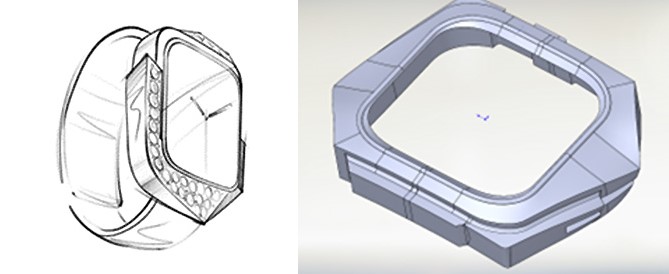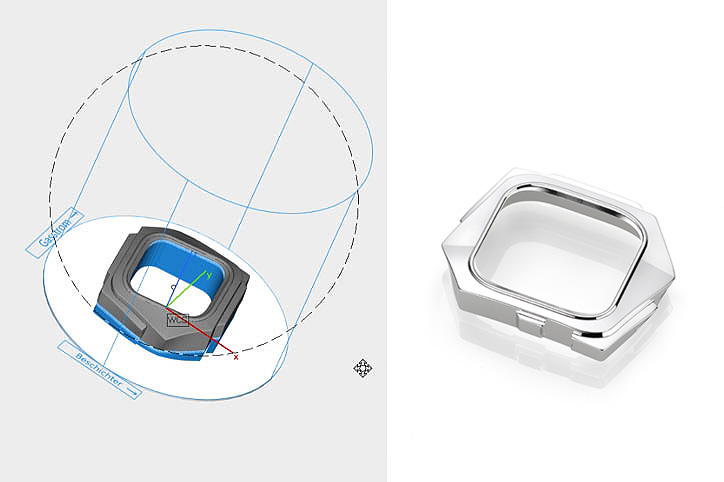Compared to conventional processing methods in precious metal technology, additive manufacturing represents a progressive and innovative approach.
We have already presented the general advantages of hybrid manufacturing such as material efficiency, design freedom and complexity as well as processing hurdles such as castability, tool wear and recycling costs of PGM materials in detail in our blog posts „Hybrid manufacturing in precious metals: The combination of additive and subtractive manufacturing methods“ and „Additive manufacturing in platinum-iridium„.
As a continuation of this, we will now take a look at the individual steps of hybrid manufacturing in the combination of additive 3D printing technology and subtractive CNC machining using the example of a smartwatch case made of platinum-gold – from the design to the final product.
Design phase and digital work preparation
The concept and design of the watch case was created by PGI and the design was made available to us as a model. In the case of customer orders, further details on the requirements for the end product, such as test dimensions and surface finish, are mandatory. In the next step, the data for the production of the printed semi-finished product is prepared, taking into account the requirements for the final machining process such as clamping and reference geometries.

The following factors are particularly important for the successful implementation of the specifications in a compliant precious metal product:
- Error-free STEP file (Standard for the Exchange of Product Model Data) for transfer to the CAM software of the 3D printing or turning/milling centres.
- Consideration of requirements from subsequent processes, such as measurement for additional features or finishing with known material removal.
- Consideration of application-specific requirements; simulations using the finite element method can provide information on optimisation potential, particularly for highly stressed or filigree designs.
Material selection: PlatinGold®
When choosing a high-quality precious metal alloy in the „Premium White“ category, the decision quickly falls in favour of the PlatinumGold alloy. The advantages of PlatinGold are such as mechanical properties, excellent processability, super-white colour and the high precious metal content of over 95% are presented. PlatinGold can also be excellently processed in powder form using 3D printing. The powder properties play an important role here.

Key aspects here are the morphology and size distribution of the powder particles, which are decisive for the essential flowability and a robust process. Guaranteeing these properties requires a consistently high quality of the PlatinumGold powder. C.HAFNER uses its own gas atomisation system for this purpose, which is integrated into a peripheral system designed for powder metallurgical processes. Classification by means of air classifying in conjunction with specific analysis methods makes it possible to ensure a constant supply of powder in defined specifications. Classification offers the decisive advantage of breaking up agglomerates and removing fine particles from the platinum powder, which significantly improves flowability.
Hybrid manufacturing: the combination of additive and subtractive manufacturing technologies
The watch case is a typical product example of how the advantages can be realised in practice. A significant proportion of the reduction in material costs results from near-net-shape semi-finished production using additive manufacturing. In addition, hybrid manufacturing eliminates the need to produce stamping tools. This eliminates the usual costs associated with conventional series production and at the same time, changes can be implemented at short notice. These conditions are particularly interesting for prototypes and small series. The break-even point for the hybrid vs. conventional production concept is in the upper double-digit range for the processing of gold alloys and significantly higher for the platinum alloy used.
The production processes are believed to be as follows: If the 3D printing data is correct, the product can be additively manufactured in a 3D printing machine. PGI’s watch case was produced using TRUMPF’s Truprint 1000, which is optimally configured for 3D printing with C.HAFNER’s precious metal powders. The result is an extremely robust watch case with a rough surface. It is then further processed on a CNC machine to achieve the desired smooth surface.
An allowance of a few tenths is required for finishing by machining. The volume to be machined, the machine running time and tool wear are correspondingly low. The end result is a highly precise milled part whose conformity to customer requirements is confirmed by state-of-the-art measuring systems. The hybrid watch case impresses with the highest level of quality, attractive conditions and an unbeatably low ecological footprint.
Application potential
The example of the hybrid watch case made of platinum-gold illustrates the advantages of the technology combination. The material and capital commitment, processing costs and ecological footprint are low. The digitally automated processes are both efficient and flexible. The technological expertise can also be transferred to the production of other precious metal components and represents a complementary and innovative production option. Particularly when processing PGM, the method can push the boundaries of economic efficiency and offer an attractive solution for conventionally unthinkable products. The series production of components is not only of interest to the jewellery and watch industry, but also to other sectors such as medical technology and the electrical industry.
Further insights into the joint reference project with PGI can be found on YouTube:
